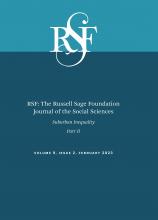Research Article
Open Access
Finding Integrated Schools? Latino Families Settle in Diverse Suburbs, 2000–2015
Shruti Bathia, Bruce Fuller, Claudia Galindo, Francisco Lagos, Sophia Rabe-Hesketh
RSF: The Russell Sage Foundation Journal of the Social Sciences February 2023, 9 (2) 104-131; DOI: https://doi.org/10.7758/RSF.2023.9.2.05
Shruti Bathia
aPhD in statistics and measurement at the Berkeley School of Education at the University of California, Berkeley, United States, and conducts research at Amazon
Bruce Fuller
bProfessor in the Berkeley School of Education at the University of California, Berkeley, United States
Claudia Galindo
cProfessor of education policy in the College of Education at the University of Maryland College Park, United States
Francisco Lagos
dPostdoctoral associate in the College of Education at the University of Maryland College Park, United States
Sophia Rabe-Hesketh
eStatistician at the University of California, Berkeley, United States

REFERENCES
- ↵
- Ackert, Elizabeth,
- Robert Crosnoe, and
- Tama Leventhal
- ↵
- Alba, Richard
- ↵
- Alba, Richard, and
- Victor Nee
- ↵
- Ardon, Ken, and
- Michael Hatch
- ↵
- Bean, Frank D.,
- Susan K. Brown, and
- James D. Bachmeier
- ↵
- ↵
- ↵
- Bendixen & Amandi International
- ↵
- Bourdieu, Pierre, and
- Jean-Claude Passeron
- ↵
- Clotfelter, Charles,
- Steven Hemelt,
- Helen F. Ladd, and
- Mavzuna Turaeva
- ↵
- Cook, Thomas
- ↵
- Diamond, John,
- Linn Posey-Maddox, and
- María Velázquez
- ↵
- Domina, Thurston,
- Nikolas Pharris-Ciurej,
- Andrew M. Penner,
- Emily K. Penner,
- Quentin Brummet,
- Sonya R. Porter, and
- Tanya Sanabria
- ↵
- ↵
- Dondero, Molly, and
- Chandra Muller
- ↵
- Ee, Jongyeon, and
- Patricia Gándara
- ↵
- Fahle, Erin M.,
- Sean F. Reardon,
- Demetra Kalogrides,
- Ericka S. Weathers, and
- Heewon Jang
- ↵
- Federal Reserve Bank of Minneapolis
- ↵
- Fiel, Jeremy
- ↵
- Fiel, Jeremy
- ↵
- Flippen, Chenoa A., and
- Dylan Farrell-Bryan
- ↵
- Frankenberg, Erica,
- Christopher S. Fowler,
- Sarah Asson, and
- Ruth Krebs Buck
- ↵
- Frasure-Yokley, Lorrie
- ↵
- Frey, William
- ↵
- Fuller, Bruce
- ↵
- ↵
- Fuller, Bruce,
- Shruti Bathia,
- Margaret Bridges,
- Yoonjeon Kim,
- Claudia Galindo, and
- Francisco Lagos
- ↵
- Fuller, Bruce,
- Yoonjeon Kim,
- Claudia Galindo,
- Shruti Bathia,
- Margaret Bridges,
- Greg J. Duncan, and
- Isabel García Valdivia
- ↵
- Goldsmith, Pat, and
- Martin Puga Jr.
- ↵
- Hall, Matthew, and
- Jacob Hibel
- ↵
- Jenkins, Jade Marcus,
- Tyler W. Watts,
- Katherine Magnuson,
- Elizabeth T. Gershoff,
- Douglas H. Clements,
- Julie Sarama, and
- Greg J. Duncan
- ↵
- Johnson, Rucker
- ↵
- Kneebone, Elizabeth, and
- Alan Berube
- ↵
- Kochher, Rakesh,
- Richard Fry, and
- Paul Taylor
- ↵
- Lewis-McCoy, R. L’Heureux
- ↵
- ↵
- Lichter, Daniel T.,
- Brian C. Thiede, and
- Matthew M. Brooks
- ↵
- Livingston, Gretchen
- ↵
- Ludwig-Dehm, Sarah M., and
- John Iceland
- ↵
- Massey, Douglas S
- ↵
- Massey, Douglas S., and
- Amelie Constant
- ↵
- Massey, Douglas S., and
- Jonathan Tannen
- ↵
- Meckler, Laura, and
- Kate Rabinowitz
- ↵
- ↵
- National Center for Education Statistics (NCES)
- ↵
- National Center for Education Statistics (NCES)
- ↵
- Ong, Paul, and
- Silvia González
- ↵
- Orfield, Gary
- ↵
- Orfield, Gary, and
- Chungmei Lee
- ↵
- Owens, Ann
- ↵
- ↵
- Owens, Ann, and
- Peter Rich
- ↵
- ↵
- Portes, Alejandro, and
- Min Zhou
- ↵
- Reardon, Sean F., and
- Claudia Galindo
- ↵
- ↵
- ↵
- Reardon, Sean F., and
- John T. Yun
- ↵
- Reardon, Sean F., and
- John T. Yun
- ↵
- Reardon, Sean F.,
- John T. Yun, and
- Michal Kurlaender
- ↵
- Rich, Peter,
- Jennifer Candipan, and
- Ann Owens
- ↵
- Richards, Meredith,
- Kori James Stroub, and
- Camila Cigarroa Kennedy
- ↵
- Rotberg, Iris C
- ↵
- Simms, Angela
- ↵
- Snijders, Tom, and
- Roel J. Bosker
- ↵
- Statista
- ↵
- Stone, Lyman
- ↵
- ↵
- Suro, Roberto,
- Jill H. Wilson, and
- Audrey Singer
- ↵
- Telles, Edward, and
- Vilma Ortiz
- ↵
- Tran, Van C., and
- Nicol M. Valdez
- ↵
- U.S. Census Bureau
- ↵
- Valenzuela, Angela
In this issue
Finding Integrated Schools? Latino Families Settle in Diverse Suburbs, 2000–2015
Shruti Bathia, Bruce Fuller, Claudia Galindo, Francisco Lagos, Sophia Rabe-Hesketh
RSF: The Russell Sage Foundation Journal of the Social Sciences Feb 2023, 9 (2) 104-131; DOI: 10.7758/RSF.2023.9.2.05
Jump to section
Related Articles
- No related articles found.
Cited By...
- No citing articles found.





